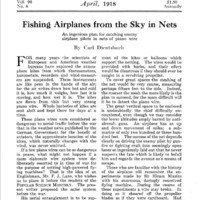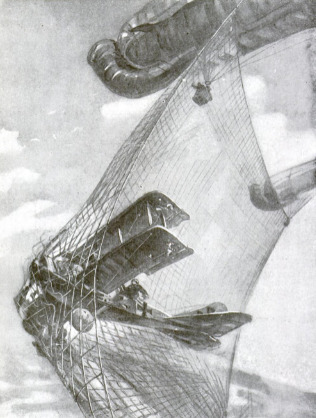Anti-airplanes net
Item
-
Title (Dublin Core)
-
Anti-airplanes net
-
Article Title and/or Image Caption (Dublin Core)
-
Fishing Airplanes from the Sky in Nets. An ingenious plan for catching enemy airplane pilots in nets of piano wire
-
extracted text (Extract Text)
-
FOR many years the scientists of
European and American weather
bureaus have explored the atmos-
phere kites from which thermometers,
barometers, recorders and wind-measur-
ers are suspended. These instruments
are like pens in the hands of the air;
for the air writes down how hot and cold
it is, how much it weighs, how fast it is
moving, and how wet it is. The kites
are flown from thin but very strong
piano wire. Whole batteries of kites are
sent aloft and kept there for days at a
time.
These piano wires were considered so
dangerous to aerial traffic before the war
that in the weather news published by the
German Government for the benefit of
aviators, the approximate location of the
kites, which naturally changes with the
wind, was never omitted.
If a few piano wires can be so dangerous
in peace, what might not happen if a
more elaborate wire system were de-
liberately resorted to in time of war for
the purpose of netting high-powered fly-
ing machines? That is the idea of an
Englishman, Mr. F. J. Lane, who wishes
us to place it before the readers of the
POPULAR SCIENCE MONTHLY. The pres-
ent writer proposed the same system
before the war.
His aerial entanglement is to be sup-
ported in feeble winds preferably by ecap-
tive balloons or by kites. It is obvious
that the system would hardly succeed in
broad daylight, but it would be un-
questionably efficacious at night, pro-
vided the enemy could not see the upper-
most of the kites or balloons which
support the netting. The wires would be
provided with barbs, and their effect
would be disastrous if they should ever be
caught in a revolving propeller.
To cover great spaces the meshing of
the net would be very coarse, measuring
perhaps fifteen feet to the side. Indeed,
the coarser the mesh the more likely is the
plan to succeed, for the more difficult will
it be to detect the piano wire.
The great vertical space to be enclosed
is undoubtedly the chief difficulty en-
countered, even though we may consider
the lower altitudes amply barred by anti-
aircraft guns, An airplane has an up
and down movement of miles; a sub-
marine of only two hundred or three hun-
dred feet. The success of the net depends
clearly on driving the enemy pilot by gun-
fire or fighting craft into seemingly open
lanes so ingeniously laid out that he never
suspects the fate which is likely to befall
him and regards the avenue as a means of
escape.
Those who are familiar with the history
of the airplane will remember the ex-
periments made by Sir Hiram Maxim
with his enormous, daringly conceived
flying machine. During the course of
these experiments a wire stay broke. In
doing so it sheared off the propeller
blades as if they were cardboard. Had
the machine been actually flying in the
air, it is easy to imagine what would have
happened. And so with the enemy air-
plane that plunges into the net that Mr.
Lane proposes. Any enemy pilot would
crash to a ghastly death.
-
Contributor (Dublin Core)
-
Carl Dientsbach (writer)
-
F. J. Lane (inventor)
-
Language (Dublin Core)
-
eng
-
Date Issued (Dublin Core)
-
1918-04
-
pages (Bibliographic Ontology)
-
483
-
Rights (Dublin Core)
-
Public Domain (Google digitized)
-
Archived by (Dublin Core)
-
Filippo Valle
-
Alberto Bordignon (Supervisor)
 Popular Science Monthly, v. 92, n. 4, 1918
Popular Science Monthly, v. 92, n. 4, 1918



